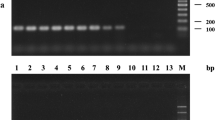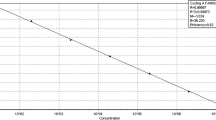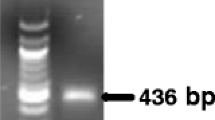Abstract
Colletotrichum coccodes causes dangerous potato and tomato diseases, known as anthracnose and black spot. Morphologically, they are often difficult to distinguish from diseases caused by other microorganisms. On green tomato fruits, the disease may be asymptomatic; it appears only on ripe red fruits. For quick and accurate diagnosis and identification of the pathogen, a test system for real-time PCR is proposed. To develop a test system, the nucleotide sequence of the glycerol-3-phosphate dehydrogenase gene was determined in 45 different strains of C. coccodes. Based on the results obtained and analysis of similar sequences of other species available in the GenBank Database, C. coccodes species-specific primers and a probe were designed. To test the specificity of the created test system, PCR was done with DNA isolated from pure cultures of 15 different species of parasitic and saprotrophic fungi associated with tomato and potato plants (Fusarium oxysporum, Fusarium verticillium, Phomopsis phaseoli, Alternaria alternatа, Helminthosporium solani, Colletotrichum coccodes, Phellinus ferrugineovelutinus, Stemphylium vesicarium, Helminthosporium solani, Phomopsis phaseoli, Neonectria radicicola, Rhizoctonia solani, Penicillium sp., Cladosporium fulvum, and Cladosporium cladosporioides). The presence of Colletotrichum coccodes DNA was determined at a 20‒27 threshold cycle. The remaining types of fungi were determined after 40 cycles or were not detected at all. The test system makes it possible to confidently detect in the analyzed PCR-mixture concentrations of C. coccodes exceeding 0.01 ng/mm3. The test system was used to study the presence of C. coccodes in tomato leaves with symptoms of fungal diseases and potato tubers without external symptoms of disease. Leaves with fungal lesion symptoms were collected from two different fields in Krasnodar krai; tubers, from the fields in Kostroma, Moscow, Kaluga, and Nizhny Novgorod oblasts. A single tomato leaf containing C. coccodes DNA was found, while the presence of C. coccodes DNA tubers grown in Kostroma, Moscow, and Kaluga oblasts was detected in five samples.
Similar content being viewed by others
REFERENCES
Andrivon, D., Lucas, J.-M., Guérin, C., and Jouan, B., Colonization of roots, stolons, tubers and stems of various potato (Solanum tuberosum) cultivars by the black-dot fungus Colletotrichum coccodes, Plant Pathol., 1998, vol. 47, pp. 440‒445.
Barkdoll, A.W. and Davis, J.R., Distribution of Colletotrichum coccodes in Idaho and variation in pathogenicity on potato, Plant Dis., 1992, vol. 76, pp. 131‒135.
Belov, G.L., Belosokhov, A.F., Kutuzova, I.A., Statsyuk, N.V., Chudinova, E.M., Alexandrova, A.V., Kokaeva, L.Yu., and Elansky, S.N., Colletotrichum coccodes in potato and tomato leaves in Russia, J. Plant Dis. Prot., 2018, vol. 125, pp. 311‒317.
Ben-Daniel, B., Bar-Zvi, D., and Tsror (Lahkim), L., Transmission of Colletotrichum coccodes via tomato seeds, Phytoparasitica, 2010, vol. 38, no. 2, pp. 167‒174.
Cullen, D.W., Lees, A.K., Toth, I.K., and Duncan, J.M., Detection of Colletotrichum coccodes from soil and potato tubers by conventional and quantitative real-time PCR, Plant Pathol., 2002, vol. 51, pp. 281‒292.
Dillard, H.R., Survival of Colletotrichum coccodes in New York, Phytopathology, 1990, vol. 80, p. 1026.
Dillard, H.R., The pathogen and its hosts, in Colletotrichum: Biology, Pathology and Control, Bailey, J.A. and Jeger, M.J., Eds., Wallingford: CAB International, 1992, pp. 225‒236.
Dillard, H.R. and Cobb, A.C., Persistence of Colletotrichum coccodes on tomato roots and in soil, Phytopathology, 1993, vol. 83, p. 1345.
Hunger, R.M. and McIntyre, G.A., Occurrence, development, and losses associated with silver scurf and black dot on Colorado potatoes, Am. Potato J., 1979, vol. 56, pp. 289‒306.
Johnson, D.A., Effect of foliar infection caused by Colletotrichum coccodes on yield of Russet Burbank potato, Plant Dis., 1994, vol. 78, pp. 1075‒1078.
Johnson, D.A., Rowe, R.C., and Cummings, T.F., Incidence of Colletotrichum coccodes in certified potato seed tubers planted in Washington state, Plant Disease, 1997, vol. 81, pp. 1199‒1202.
Kutuzova, I.A., Intraspecific variability of plant pathogenic fungy Colletotrichum coccodes and Helminthosporium solani, Cand. Sci. (Biol.) Dissertation, Moscow, 2018.
Kutuzova, I.A., Kokaeva, L.Yu., Pobedinskaya, M.A., Krutyakov, Yu.A., Skolotneva, E.S., Chudinova, E.M., and Elansky, S.N., Resistance of Helminthosporium solani strains to the fungicides applied for tuber treatment, J. Plant Pathol., 2017, vol. 99, no. 3, pp. 635‒642.
Lees, A.K. and Hilton, A.J., Black dot (Colletotrichum coccodes): An increasingly important disease of potato, Plant Pathol., 2003, vol. 52, pp. 3‒12.
Raid, R.N. and Pennypacker, S.P., Weeds as hosts for Colletotrichum coccodes, Plant Dis., 1987, vol. 71, pp. 643‒646.
Read, P.J. and Hide, G.A., Effects of fungicides on the growth and conidial germination of Colletotrichum coccodes and on the development of black dot disease of potatoes, Ann. Appl. Biol., 1995, vol. 126, pp. 437‒447.
Read, P.J. and Hide, G.A., Effects of inoculum source and irrigation on black dot disease of potatoes [Colletotrichum coccodes (Wallr.) Hughes] and its development during storage, Potato Res., 1988, vol. 31, pp. 493‒500.
Tsror (Lahkim), L., Erlich, O., and Hazanovsky, M., Effect of Colletotrichum coccodes on potato yield, tuber quality, and stem colonization during spring and autumn, Plant Dis., 1999, vol. 83, pp. 561‒565.
Funding
The study was supported by the Russian Science Foundation, grant no. 18-76-00009.
Author information
Authors and Affiliations
Corresponding authors
Ethics declarations
ETHICS APPROVAL AND CONSENT TO PARTICIPATE
This work does not contain any studies involving human and animal subjects.
CONFLICT OF INTEREST
The authors of this work declare that they have no conflicts of interest.
Additional information
Publisher’s Note.
Pleiades Publishing remains neutral with regard to jurisdictional claims in published maps and institutional affiliations.
Rights and permissions
About this article
Cite this article
Ryazantsev, D.Y., Chudinova, E.M., Kokaeva, L.Y. et al. Detection of Colletotrichum coccodes by Real-Time PCR. Biol Bull Rev 13 (Suppl 1), S108–S113 (2023). https://doi.org/10.1134/S2079086423070101
Received:
Revised:
Accepted:
Published:
Issue Date:
DOI: https://doi.org/10.1134/S2079086423070101




